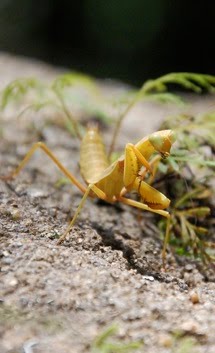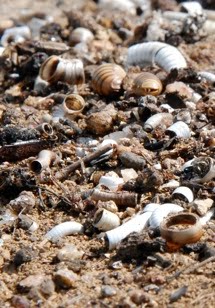
...Photos. Sorry, I can't give away an actual lemur. They are very hard to mail. No matter how you lick the stamps, they just fall right off the fur.
A few weekends ago, we were lucky enough to visit several forests and parks near Andasibe. They were packed full of lemurs and other wonderful creatures. Just to make sure you come back, I will start with the other wonderful creatures.
In a few days, I will unleash the lemur (photos that is).

Sadly, a lot of the forests in Madagascar have been cut down or burned, but this is one of the lucky forests that has escaped. The sciency way of saying that is "primary forest". Or to be even more specific, it is a "primary montane rain forest".

It is full of giant ferns and palms. It looks like a perfect place for a pet dinosaur.

Or perhaps a giant grub instead.

See? Big.

At night the forest comes alive with all kinds nocturnal thingamabobbers like tiny lemurs, funny-nosed bats, crawly insects and marvelous chameleons like this fellow. Well, most of the chameleons are not nocturnal, but they are much easier to find at night. A shining flashlight turns their eyeballs into two little headlights. All their wonderful camouflage makes them very hard to find during the day when they are out hunting insects and other tasty prey. Look at the special feet that are perfect for latching onto twigs. But they're terrible for strolling on the ground.

This is a baby Parson's chameleon. Some people think it is the largest chameleon in the world. It lives about 7 years, so this one still has time to grow into an an 18 inch long giant (without the tail).

This is
Gigantis madagascarius. Otherwise known as the goliath bird-eating chameleon.

Ok, not quite. Unless of course the birds are very, very tiny.

But the birds aren't tiny. And some of them do indeed like to eat chameleons. That is if they can find them. This one looks a whole lot like a branch and not a tasty morsel.
What sticky-footed fellow is hiding behind that leaf?

The striking Madagascar day gecko, that's who. He's on the hunt for some insects.

Like these guard termites who make sure no intruders try to break into their home sweet termite mound. Intruders have a nasty habit of tracking mud all over the place. Oh yeah, and eating everyone too.
 Hey, it's a little rolly polly
Hey, it's a little rolly polly (pill bug).

Partly right. It is a roly-poly. But it is not little. This is a smaller and dead one. All the live ones rolled up into ping-pong-sized balls as soon as I touched them.
A wonderful frog. A petite one too. She could use a penny as an umbrella (that is if the penny had a handle and she an opposable thumb).
 Nice spider!
Nice spider! Not so fast. Count those legs again. It only has six legs. Its two antennae are colored to look like two more legs. That big abdomen is quite spider like too. But its other two main body parts aren't. Spiders only have two main body parts. Insects have three.
So what is it? I have no idea. But it's not a spider.

Speaking of spiders. Here is an unfortunate moth stuck in spider web. Let's take a closer look.

Hum, that's funny? This moth has eight legs. That was probably the last thought of a lot of insects right before this thorn spider wrapped them up and ate them.

And, if you aren't careful, you could get wrapped up too. This web is taller than I am. Yikes.

And this is the home of some very special spiders. There are over 40,ooo different spider species in the world. And almost all of them prefer to be alone. The only time one adult spider hangs out with another adult is to make babies or to eat the other one for lunch. But there are about 20-30 spider species that do like to hangout together. They all help build a giant web/nest kind of thing and when some unlikely insect gets caught in the web. Dozens or even hundreds of spiders come bounding in from all sides to eat it or wrap it up for a snack later.

My wife Cindy and I after a great day of lemur and non-lemur spotting.

Don't worry, the lemurs are coming. Check back in a few days.

 Sadly, a lot of the forests in Madagascar have been cut down or burned, but this is one of the lucky forests that has escaped. The sciency way of saying that is "primary forest". Or to be even more specific, it is a "primary montane rain forest".
Sadly, a lot of the forests in Madagascar have been cut down or burned, but this is one of the lucky forests that has escaped. The sciency way of saying that is "primary forest". Or to be even more specific, it is a "primary montane rain forest". At night the forest comes alive with all kinds nocturnal thingamabobbers like tiny lemurs, funny-nosed bats, crawly insects and marvelous chameleons like this fellow. Well, most of the chameleons are not nocturnal, but they are much easier to find at night. A shining flashlight turns their eyeballs into two little headlights. All their wonderful camouflage makes them very hard to find during the day when they are out hunting insects and other tasty prey. Look at the special feet that are perfect for latching onto twigs. But they're terrible for strolling on the ground.
At night the forest comes alive with all kinds nocturnal thingamabobbers like tiny lemurs, funny-nosed bats, crawly insects and marvelous chameleons like this fellow. Well, most of the chameleons are not nocturnal, but they are much easier to find at night. A shining flashlight turns their eyeballs into two little headlights. All their wonderful camouflage makes them very hard to find during the day when they are out hunting insects and other tasty prey. Look at the special feet that are perfect for latching onto twigs. But they're terrible for strolling on the ground.  This is a baby Parson's chameleon. Some people think it is the largest chameleon in the world. It lives about 7 years, so this one still has time to grow into an an 18 inch long giant (without the tail).
This is a baby Parson's chameleon. Some people think it is the largest chameleon in the world. It lives about 7 years, so this one still has time to grow into an an 18 inch long giant (without the tail). This is Gigantis madagascarius. Otherwise known as the goliath bird-eating chameleon.
This is Gigantis madagascarius. Otherwise known as the goliath bird-eating chameleon. Ok, not quite. Unless of course the birds are very, very tiny.
Ok, not quite. Unless of course the birds are very, very tiny. But the birds aren't tiny. And some of them do indeed like to eat chameleons. That is if they can find them. This one looks a whole lot like a branch and not a tasty morsel.
But the birds aren't tiny. And some of them do indeed like to eat chameleons. That is if they can find them. This one looks a whole lot like a branch and not a tasty morsel. Like these guard termites who make sure no intruders try to break into their home sweet termite mound. Intruders have a nasty habit of tracking mud all over the place. Oh yeah, and eating everyone too.
Like these guard termites who make sure no intruders try to break into their home sweet termite mound. Intruders have a nasty habit of tracking mud all over the place. Oh yeah, and eating everyone too. Partly right. It is a roly-poly. But it is not little. This is a smaller and dead one. All the live ones rolled up into ping-pong-sized balls as soon as I touched them.
Partly right. It is a roly-poly. But it is not little. This is a smaller and dead one. All the live ones rolled up into ping-pong-sized balls as soon as I touched them. Nice spider! Not so fast. Count those legs again. It only has six legs. Its two antennae are colored to look like two more legs. That big abdomen is quite spider like too. But its other two main body parts aren't. Spiders only have two main body parts. Insects have three. So what is it? I have no idea. But it's not a spider.
Nice spider! Not so fast. Count those legs again. It only has six legs. Its two antennae are colored to look like two more legs. That big abdomen is quite spider like too. But its other two main body parts aren't. Spiders only have two main body parts. Insects have three. So what is it? I have no idea. But it's not a spider. Speaking of spiders. Here is an unfortunate moth stuck in spider web. Let's take a closer look.
Speaking of spiders. Here is an unfortunate moth stuck in spider web. Let's take a closer look. Hum, that's funny? This moth has eight legs. That was probably the last thought of a lot of insects right before this thorn spider wrapped them up and ate them.
Hum, that's funny? This moth has eight legs. That was probably the last thought of a lot of insects right before this thorn spider wrapped them up and ate them. And, if you aren't careful, you could get wrapped up too. This web is taller than I am. Yikes.
And, if you aren't careful, you could get wrapped up too. This web is taller than I am. Yikes. And this is the home of some very special spiders. There are over 40,ooo different spider species in the world. And almost all of them prefer to be alone. The only time one adult spider hangs out with another adult is to make babies or to eat the other one for lunch. But there are about 20-30 spider species that do like to hangout together. They all help build a giant web/nest kind of thing and when some unlikely insect gets caught in the web. Dozens or even hundreds of spiders come bounding in from all sides to eat it or wrap it up for a snack later.
And this is the home of some very special spiders. There are over 40,ooo different spider species in the world. And almost all of them prefer to be alone. The only time one adult spider hangs out with another adult is to make babies or to eat the other one for lunch. But there are about 20-30 spider species that do like to hangout together. They all help build a giant web/nest kind of thing and when some unlikely insect gets caught in the web. Dozens or even hundreds of spiders come bounding in from all sides to eat it or wrap it up for a snack later. My wife Cindy and I after a great day of lemur and non-lemur spotting.
My wife Cindy and I after a great day of lemur and non-lemur spotting.





















 Glyptodon
Glyptodon Penguin
Penguin















